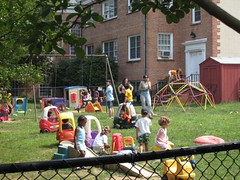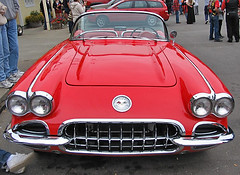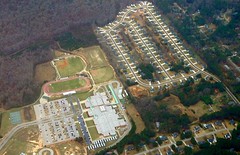I'm especially glad to have written these in 2008

Posted December 30, 2008 at 2:00PM
Last week I took a look at some of the best places that I've highlighted in this blog. Today, I'd like to add another end-of-year indulgence, and highlight some of my favorite stories from the blog, apart from the ones about individual smart growth successes. It was fun to look back over 200 or so posts and try to pick ten favorites. And, hey, it wasn't entirely self-indulgent: one of them was written by someone else. Here they are:
Trouble the Water - a note from NOLA (March 9, 2008). "Trouble the Water is the name of a new documentary film about the survivors of Hurricane Katrina. At this point, I bet I've seen a half-dozen such films, but this one is the best. What sets it apart is that it tells the story from the inside out, and from the point of view of a single remarkable couple, Kimberly Rivers Roberts and Scott Roberts, who were stuck in their home Ninth Ward during the storm, hanging on to rowboats and rooftops and trying to help their neighbors, while recording on a home camcorder . . ." (I also wrote a followup here.)
Two Wheels Good (April 10, 2008). "Above, you see my two favorite bikes, sitting pretty in our back yard.  I'm showing them because, for me, this week is all about getting my lazy behind in gear and getting into some semblance of decent physical shape. Gaining 10 pounds every winter and losing five every summer is unsustainable, to allude to the popular environmental word, and all I did this past winter was work too much, stress too much, and watch basketball. So it's time . . ."
I'm showing them because, for me, this week is all about getting my lazy behind in gear and getting into some semblance of decent physical shape. Gaining 10 pounds every winter and losing five every summer is unsustainable, to allude to the popular environmental word, and all I did this past winter was work too much, stress too much, and watch basketball. So it's time . . ."
Rethinking environmental impacts to manage growth (May 13, 2008). "When faced with a situation where rapid growth is occurring, such as I discussed yesterday, the best thing to do environmentally is to manage and shape it so that a good quality of life is maintained with the least environmental harm. This is fundamentally about per capita, or per household, thinking: how can we shape the new development so that it has the least impact per increment of growth? This is the essence of smart growth. But it also represents a fairly radical departure from traditional environmental thinking (and much of environmental law) . . ."
Community ain't what it used to be: neighborhood challenges to churches and schools (part 1) (July 2, 2008). "What finally prompted me to write is a ferocious battle in my neighborhood challenging a Baptist church's proposed addition to its building.  The addition would house a non-profit child care center, a language school for kids, and the Washington Conservatory of Music, which the church hosts . . . Maybe it's just me, but these sound like the sorts of things that churches have always done, and our communities are better because of it. I can't imagine this kind of ruckus being raised in my youth . . ." (This was a two-part story, and part two is here.)
The addition would house a non-profit child care center, a language school for kids, and the Washington Conservatory of Music, which the church hosts . . . Maybe it's just me, but these sound like the sorts of things that churches have always done, and our communities are better because of it. I can't imagine this kind of ruckus being raised in my youth . . ." (This was a two-part story, and part two is here.)
What a joke: auto-dependent corporate HQ in sprawl claims to be "carbon neutral" (July 5, 2008). "What we really have here is yet another high-tech building calling itself "green" but that warrants the label only if you completely discount the sprawling, totally automobile-dependent location. Research proves that buildings in sprawling locations cause far more carbon emissions from employees and visitors driving to and from them than they save with energy-efficient building technology . . ."
Little Red Corvette: the songs just aren't the same (September 11, 2008). "When was the last time you heard a really good car or truck song?  Does the 21st century have a "Six Days on the Road," "Take It Easy," or "Little Red Corvette"? It certainly doesn't have a "409," "Little Deuce Coupe," or "I Get Around," to name but three classic Beach Boys tunes, or the best of all American road songs, "Route 66." Our decade doesn't have any of these, writes J. Freedom du Lac in The Washington Post, because driving just isn't the expression of freedom and "fun, fun, fun" that it was for earlier generations . . ."
Does the 21st century have a "Six Days on the Road," "Take It Easy," or "Little Red Corvette"? It certainly doesn't have a "409," "Little Deuce Coupe," or "I Get Around," to name but three classic Beach Boys tunes, or the best of all American road songs, "Route 66." Our decade doesn't have any of these, writes J. Freedom du Lac in The Washington Post, because driving just isn't the expression of freedom and "fun, fun, fun" that it was for earlier generations . . ."
A photo essay on school sprawl (part 1) (September 18, 2008). "Schools used to be the heart of a neighborhood or community. Children and not a few teachers could walk to class, or to the playground or ball field on the weekend. This was relatively easy to do, because the schools were placed within, not separated from, their neighborhoods.  They were human-scaled and their architecture was not just utilitarian, but signaled their importance in the community. Now it has become hard to tell one from a Walmart or Target . . ." (Part two of this two-part story is here.)
They were human-scaled and their architecture was not just utilitarian, but signaled their importance in the community. Now it has become hard to tell one from a Walmart or Target . . ." (Part two of this two-part story is here.)
An open letter to the smart growth community (October 22, 2008). "I am proud to have been at the center of the national smart growth movement since its beginning. But I believe it is time for advocates and practitioners to embrace a broader, more holistic vision of what smart, sustainable development should be in the 21st century . . ."
Rachel explains: "The hidden perils of poorly-connected streets, or why I'm afraid of German Shepherds" (November 25, 2008). "Between me and the spoils of Jenny's indulged childhood lay the proverbial fork in the (badly-planned) road. Which way to go?  The safe but loooong route (0.5 miles)...or the treacherous shortcut (0.2 miles)? The shortcut was a substantial timesaver for a little kid with little legs, but it would mean scaling Jenny's back fence commando-style and then running the gauntlet of 'family dogs' (read: rabid German Shepherd psycho killer hellhounds) to get to the back door . . ."
The safe but loooong route (0.5 miles)...or the treacherous shortcut (0.2 miles)? The shortcut was a substantial timesaver for a little kid with little legs, but it would mean scaling Jenny's back fence commando-style and then running the gauntlet of 'family dogs' (read: rabid German Shepherd psycho killer hellhounds) to get to the back door . . ."
Saving history from sprawl: threats to Civil War battlefields (December 4, 2008). "In the map above, the area in green is the currently preserved portion of the Fredericksburg-Spotsylvania National Battlefield. The area in yellow, where the map notes the location of several sectors of Union troops during the fighting, is in private hands and subject to development. The proposed Walmart site is in red . . ."
Apart from my favorite individual posts, there were three continuing stories that I ended up giving a lot of space to: at least ten posts (depending on what I count), such as this one, on how economic conditions have been changing the market for smart growth; several on my pet peeve of "green" buildings in dumb places, such as the one above on the corporate headquarters; and several on the relationship between sprawl and obesity (example here; and just this week I learned of a new Australian study).
I love the opportunity to write these things (and to invite Rachel and others occasionally to do so). Thanks so much for reading, and I'm looking forward to more in the new year. Let's make it a good one.